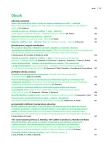Endoscopic classification of colon and rectal neoplasias
Authors:
Miroslav Zavoral; Gabriela Vojtěchová; Štěpán Suchánek
Authors‘ workplace:
Interní klinika 1. LF UK a Ústřední vojenská nemocnice – Vojenská fakultní nemocnice Praha, přednosta prof. MUDr. Miroslav Zavoral, Ph. D.
Published in:
Vnitř Lék 2014; 60(7-8): 664-668
Category:
100th Birthday - prof. Z. Mařatka
Overview
Along with the dynamic evolution of the new field of digestive endoscopy, the need of unified and unambiguous terms for endoscopic findings arose in the second half of the 20th century. In collaboration with the OMED members, professor Zdeněk Mařatka drew up the first internationally acknowledged terminology for digestive endoscopy which was used in the full range for a period of almost 20 years. The technical progress later brought with it endoscopes which made it possible to view flat lesions, frequently overlooked until then. The classification of the surface lesions was further specified by the Paris Classification which drew from the experience of Japanese endoscopists. Thanks to the new endoscopic methods of imaging mucosa in vivo and the pit-pattern and vascular-pattern classification, we can currently estimate the biological nature of lesion with great accuracy and therefore choose the best therapeutic procedure.
Key words:
adenoma – colonoscopy – colorectal carcinoma – Mařatka classification – Paris classification – pit-pattern – vascular-pattern
Sources
1. Bozzini P. Der Lichtleiter Oder Die Beschreibung Einer Einfachen Vorrichtung Und Ihrer Anwendung Zur Erleuchtung Innerer Hohlen Und Zwischenraume des Lebenden Animalischen Korpers. Verlag Des Landes Industrie Compoir: Weimar (Germany) 1807.
2. Blankenhorn DH, Hirsch J, Ahrens EH jr. Transintestinal intubation: technic for measurement of gut length and physiologic sampling at known loci. Proc Soc Exp Biol 1955; 88(3): 356.
3. Fox JA, Kreel L. Technique of retrograde colonic intubation and its initial application to high colonic biopsy. Gut 1967; 8(1): 77–80.
4. Niwa H, Fujino M, Yoshitoshi Y. Colonic fiberscopy for routine practice. IInd World Congress of Gastrointinal Endoscopy. Rome and Copenhagen 1970. Piccin Medical Books: Padova 1972.
5. Mařatka Z. Terminology, definitions and diagnostic criteria in digestive endoscopy. Scand J Gastroenterol 1984; 19(Suppl 103): 1–74.
6. Aiko T, Sasako M. The new Japanese classification of gastric carcinomas: points to be revised. Gastric Cancer 1998; 1(1): 25–30.
7. Kato H, Sakamoto T, Otsuka H et al. Endoscopic diagnosis and treatment for colorectal cancer. In: Ettarh R (ed). Colorectal cancer – from prevention to patient care. InTech 2012: 327–348. ISBN 978–953–51–0028–7.
8. The Paris endoscopic classification of superficial neoplastic lesions: esophagus, stomach, and colon. Gastrointestinal Endoscopy 2003; 58(Suppl): 1–21.
9. Kudo S. Early colorectal cancer. Tokyo: Igaku-shoin 1996. ISBN 13: 9780896403307. ISBN 10: 896403300.
10. Kudo S, Tamura S, Nakajima T et al. Diagnosis of colorectal tumorous lesions by magnifying endoscopy. Gastrointest Endosc 1996; 44(1): 8–14.
11. Kogure E, Kudo S, Tamegai Y et al. Is it possible to predict histopathological findings by magnifying colonoscopic „pit pattern diagnosis“? Gut 2003; 52(Suppl 6): A9.
12. Kudo S, Lambert R, Allen JI et al. Nonpolypoid neoplastic lesions of the colorectal mucosa. Gastrointestinal Endoscopy 2008; 68(1): 11–12.
13. Quirke P, Risio M, Lambert R Quality assurance in pathology in colorectal cancer screening and diagnosis. In: Segnan N, Patnick J, von Karsa L. European guidelines for quality assurance in colorectal cancer screening and diagnosis. European Union 2010: 206–232. ISBN 978–92–79–16435–4 (Printed version).
Labels
Diabetology Endocrinology Internal medicineArticle was published in
Internal Medicine

2014 Issue 7-8
Most read in this issue
- Endoscopic classification of colon and rectal neoplasias
- Acute pancreatitis – Validation of Revised Atlanta Classification on 159 patients and prognostic factors
- Crohn's Disease Surgery
- Management of patients with dyspepsia
